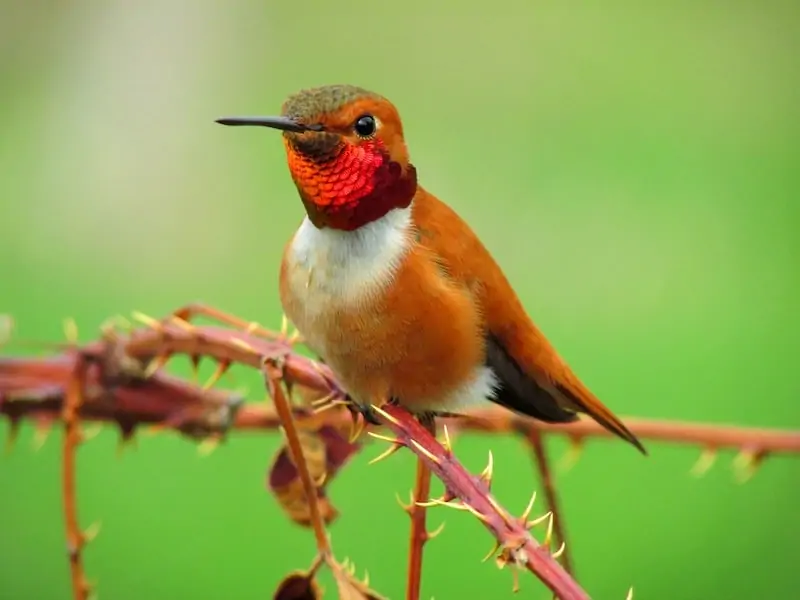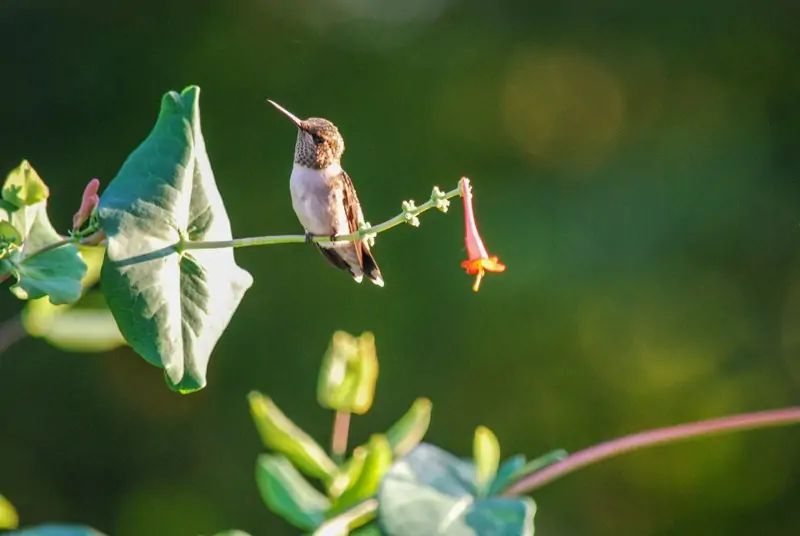There have been reports of nearly 30 different species of hummingbirds seen in the United States. Many of these are common and can be found every year, while some are rare or only accidental visitors to the U.S. When it comes to hummingbirds in Arkansas, we have found 2 species that are common or semi-common and 5 that are rare. That’s a total of 7 species of hummingbirds that may visit Arkansas.
7 HUMMINGBIRDS IN ARKANSAS
We’ve compiled a list of hummingbirds that may be seen in Arkansas based on range maps provided by authoritative sources such as allaboutbirds.org and ebird.org. The species name, images of what it looks like, descriptions of appearance, and where and when you may see them are all included for each species in this list. The two most frequent species will be listed first, followed by the five uncommon ones.
Stay tuned until the conclusion of the article for hummingbird attractant tips, and check this page to see when hummingbirds will be returning to your state.
Enjoy!
1. RUBY-THROATED HUMMINGBIRD

Scientific name: Archilochus colubris
The most frequent hummingbirds in the eastern section of the United States, as well as Arkansas, are Ruby-throated hummingbirds. The back is green, while the underparts are white. In some lighting, males’ necks may appear black with a ruby red hue.
They arrive in droves from their Central American wintering grounds every spring. In one nonstop flight, several of them fly across the Gulf of Mexico! With nectar feeders and flowers, Ruby-throated hummingbirds are relatively simple to attract to yards.
Throughout the spring and summer months, Ruby-throated hummingbirds may be seen across Arkansas, with a tendency to stay until early autumn. They’ll be here in April and depart in late September, so keep an eye out.
2. RUFOUS HUMMINGBIRD

Scientific name: Selasphorus rufus
When it comes to sharing feeders and chasing off other hummers, rufous hummingbirds are well-known for being particularly “feisty.” The top breast is orange, and the neck is orange-red. Males are completely orange all over. Green females with speckles on their neck and patches of rust.
They move north into the United States in the spring. In the summer, zip through California, then spend the rest of the season in the Pacific Northwest and Canada. While the rufous Hummingbird is most likely the second most commonly seen species in the eastern half of the United States behind the ruby-throated Hummingbird, they are also considered a western U.S. hummingbird.
While I wouldn’t categorize them as common, recorded sightings in Arkansas are widely distributed across the state and are seen at least once a year. Between August and January are the most common months for people to see the rufous in Arkansas.
3. BLACK-CHINNED HUMMINGBIRD

Scientific name: Archilochus alexandri
Each year, black-chinned hummingbirds travel from Mexico and Central America to the western United States to breed. In most light, males have a small strip of purple feathers at the base of their throat that is sometimes visible.
Females have a plain throat and green above and pale below, much like other hummingbird females. Hummingbirds with black chins can be found in a range of environments, from deserts to high forests, and prefer to sit on naked branches.
They have been recorded in most states along the east coast, including Arkansas, where there have been a few sightings over the years. They are a western bird that has been spotted in most of them. Because their range extends to adjacent eastern Texas, a few of them are bound to wander into Arkansas, which is not surprising.
Being a state that has black-chinned hummingbirds, you may get lucky if you find one. November through February are the best months to see it.
4. CALLIOPE HUMMINGBIRD

Scientific name: Selasphorus calliope
The Central American calliope hummingbird spends the winter in Central America, then migrates to the Pacific Northwest and western Canada during the breeding season. The calliope is the smallest bird in the United States, so that’s an impressively long migration!
Males have a distinctive magenta stripe throat that forks down on both sides of the neck. The throat and underparts of females are green, with a peachy tint.
On the east coast, Calliope Hummingbirds are uncommon, although they have been sighted in Arkansas on a few occasions. Surprisingly, none of the observed instances I discovered on eBird occurred in the last 10 years. Calliope sightings are becoming more uncommon than they were in the past, according to reports.
5. ANNA’S HUMMINGBIRD

Scientific name: Calypte anna
In reality, Anna remains in the United States. Although they may be found throughout most of their range, they are only really found in a few western states, such as California and Oregon.
In comparison to the majority of other US birds, their feathers are more vivid and iridescent. Emerald feathers cover the hummingbirds’ chest and belly, as well as their wings. The male has bright crimson cheeks and wears a variety of colorful feathers on their foreheads.
On the east coast, Anna’s are rather uncommon, however they do come around from time to time. Over the years, there have been a few sightings in Arkansas, mostly around the state. Throughout the winter months, you may get lucky.
6. BROAD-TAILED HUMMINGBIRD

Scientific name: Selasphorus platycerus
Hummingbirds that have a broad tail like to live in the highlands and breed up to 10,500 feet above sea level. The throat of males is a rosey-magenta color. The neck and cheeks of females are green, while the sides are buffy.
In the eastern United States, broad-tailed hummingbirds are uncommon. The Gulf of Mexico is to the north. In Arkansas, just a few have been documented, and sightings are mostly seen in the state’s central region.
7. BROAD-BILLED HUMMINGBIRD

Scientific name: Cynanthus latirostris
In the United States, there are just two states. Arizona and New Mexico are two states where the broad-billed hummingbird is known to breed. The purpleish-blue throat and blueish-green belly of males make it difficult to mistake them. Their beak is likewise reddish-orange with a black tip. With the typical black beak, females are a washed-out green above and below.
Outside of the southwestern U.S., broad-billed hummingbirds are quite uncommon. They’ve been known to appear in other places. In Arkadelphia, White Hall, and Conway, Arkansas has only had a few recorded sightings.
ATTRACTING HUMMINGBIRDS TO YOUR YARD
1. HANG HUMMINGBIRD FEEDERS
Hanging a nectar feeder in your garden is perhaps the most effective method of attracting hummingbirds. Hummingbirds must keep eating and finding a dependable source of nectar is critical. Pick a feeder with a red color and that is simple to disassemble and clean. More than once a week, cleaning and refilling in hot weather must be done. For most people, we recommend a saucer-shaped feeder. They’re incredibly simple to clean, operate correctly, and don’t store too much nectar.
2. MAKE YOUR OWN NECTAR
By making your own nectar, you avoid (and sometimes endanger) unnecessary (and occasionally harmful) additives. It’s a good deal, it’s simple, and it gets the job done. In a 1:4 proportion (1 cup sugar to 4 cups water), all you need to do is add plain white sugar. On how to make your own nectar without having to boil the water, we have an easy how-to article.
3. PLANT NATIVE FLOWERS
Plant hummingbird-attracting flowers in your yard, apart from a feeder, of course. They’re particularly drawn to crimson (and orange, pink, and purple) flowers, as well as trumpet or tubular-shaped blossom types. Vertical planting might help you save space. Long cascading vines of flowers may be grown vertically on an obelisk trellis or a flat trellis attached to the side of your home. Hummingbirds love these 20 plants and flowers, so take a look.
4. PROVIDE WATER
Hummingbirds require both drinking and bathing water. They will utilize baths with the appropriate “specifications,” despite their fondness for classic bird baths. You may purchase hummingbird baths or create something spectacular in your yard with these wonderful ideas.
5. PROMOTE INSECTS
Sugar isn’t sufficient for most hummingbirds, so they need protein as well. Insects make up a third of their diet. Mosquitoes, fruit flies, spiders, and gnats are all examples of this. Avoid pesticides to help your hummers. Our 5 easy tips will help you learn more about insect feeders and ways to encourage hummingbirds to feed on them.
